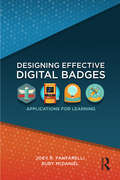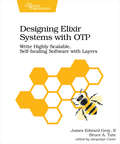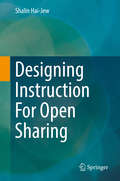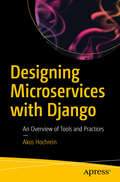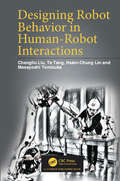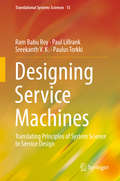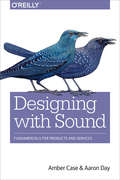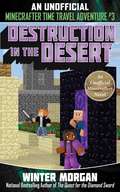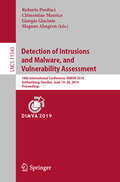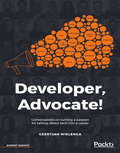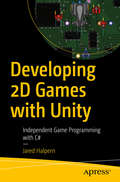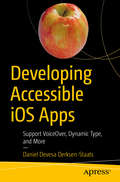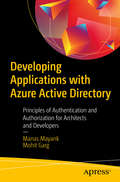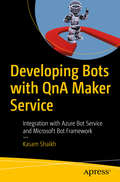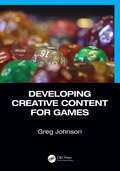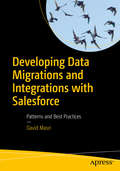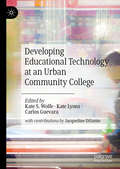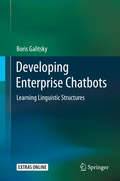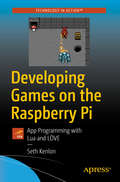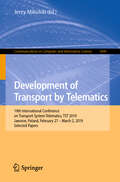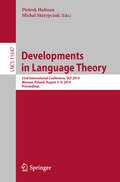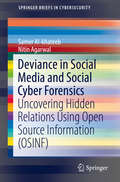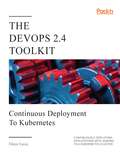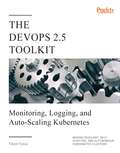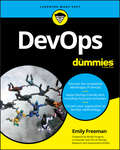- Table View
- List View
Designing Effective Digital Badges: Applications for Learning
by Joey R. Fanfarelli Rudy McDanielDesigning Effective Digital Badges is a hands-on guide to the principles, implementation, and assessment of digital badging systems. Informed by the fundamental concepts and research-based characteristics of effective badge design, this book uses real-world examples to convey the advantages and challenges of badging and showcase its application across a variety of contexts. Professionals in education, game development, mobile app development, and beyond will find strategies for practices such as credentialing, goal-setting, and motivation of their students.
Designing Elixir Systems With OTP: Write Highly Scalable, Self-healing Software with Layers
by James Edward Gray II Bruce A. TateYou know how to code in Elixir; now learn to think in it. Learn to design libraries with intelligent layers that shape the right data structures, flow from one function into the next, and present the right APIs. Embrace the same OTP that's kept our telephone systems reliable and fast for over 30 years. Move beyond understanding the OTP functions to knowing what's happening under the hood, and why that matters. Using that knowledge, instinctively know how to design systems that deliver fast and resilient services to your users, all with an Elixir focus. Elixir is gaining mindshare as the programming language you can use to keep you software running forever, even in the face of unexpected errors and an ever growing need to use more processors. This power comes from an effective programming language, an excellent foundation for concurrency and its inheritance of a battle-tested framework called the OTP. If you're using frameworks like Phoenix or Nerves, you're already experiencing the features that make Elixir an excellent language for today's demands. This book shows you how to go beyond simple programming to designing, and that means building the right layers. Embrace those data structures that work best in functional programs and use them to build functions that perform and compose well, layer by layer, across processes. Test your code at the right place using the right techniques. Layer your code into pieces that are easy to understand and heal themselves when errors strike. Of all Elixir's boons, the most important one is that it guides us to design our programs in a way to most benefit from the architecture that they run on. The experts do it and now you can learn to design programs that do the same.What You Need:Elixir Version 1.7 or greater.
Designing Instruction For Open Sharing
by Shalin Hai-JewThis textbook considers and addresses the design of online learning objects, electronic textbooks, short courses, long courses, MOOC courses, and other types of contents for open sharing. It also considers the design of online mediated communities to enhance such learning. The “openness” may be open-access, and/or it may even be open-source. The learning may range from self-directed and automated to AI robot-led to instructor-led. The main concept of this work is that design learning for open sharing, requires different considerations than when designing for closed and proprietary contexts. Open sharing of learning contents requires a different sense of laws (intellectual property, learner privacy, pedagogical strategies, technologies, media, and others). It requires different considerations of learner diversity and inclusion. It requires geographical, cultural, and linguistic considerations that are not as present in more localized designs. The open sharing aspect also has effects on learner performance tracking (assessments) and learner feedback. This textbook targets students, both undergraduate and graduate in computer science, education and other related fields. Also, professionals in this field managing online systems would find this book helpful.
Designing Microservices with Django: An Overview of Tools and Practices
by Akos HochreinExplore microservices using the Python-based Django framework and review the benefits and drawbacks of them. This book will examine what microservices look like, how they talk to each other, and how they are crafted using the Python programming language and the Django web framework.You’ll start by understanding what the key differences are between microservices and monolithic architectures. The book then does a deep dive into how microservices are built and what common models have emerged in our industry. You’ll also take an extensive look at communication and ownership patterns and examine methodologies to speed up your architecture evolution by writing less but more distributed code using the Python programming language and the Django web framework. By the end of the book, you’ll have a solid understanding of microservices architectures. Armed with a comprehensive and solid toolset, you can begin working toward systems that are more scalable, resilient, and maintainable. What You’ll LearnUnderstand the benefits and drawbacks of adopting microservicesDesign systems and architecture for resiliency and distributed ownershipWork with tools for scaling distributed system both in technical and organizational dimensionsExamine the essentials of the Django web framework
Designing Robot Behavior in Human-Robot Interactions
by Changliu Liu Te Tang Hsien-Chung Lin Masayoshi TomizukaIn this book, we have set up a unified analytical framework for various human-robot systems, which involve peer-peer interactions (either space-sharing or time-sharing) or hierarchical interactions. A methodology in designing the robot behavior through control, planning, decision and learning is proposed. In particular, the following topics are discussed in-depth: safety during human-robot interactions, efficiency in real-time robot motion planning, imitation of human behaviors from demonstration, dexterity of robots to adapt to different environments and tasks, cooperation among robots and humans with conflict resolution. These methods are applied in various scenarios, such as human-robot collaborative assembly, robot skill learning from human demonstration, interaction between autonomous and human-driven vehicles, etc. Key Features: Proposes a unified framework to model and analyze human-robot interactions under different modes of interactions. Systematically discusses the control, decision and learning algorithms to enable robots to interact safely with humans in a variety of applications. Presents numerous experimental studies with both industrial collaborative robot arms and autonomous vehicles.
Designing Service Machines: Translating Principles of System Science to Service Design (Translational Systems Sciences #15)
by Ram Babu Roy Paul Lillrank Sreekanth V. K. Paulus TorkkiThis book presents a general conceptual framework to translate principles of system science and engineering to service design. Services are co-created immaterial, heterogeneous, and perishable state changes. A service system includes the intended benefit to the customer and the structure and processes that accomplish this benefit. The primary focus is on the part of the service system that can reproduce such processes, called here a Service Machine, and methodological guidelines on how to analyze and design them. While the benefit and the process are designed based on the domain knowledge of each respective field, service production systems have common properties. The Service Machine is a metaphor that elicits the fundamental characteristics of service systems that do something efficiently, quickly, or repeatedly for a defined end. A machine is an artifact designed for a purpose, has several parts, such as inputs, energy flows, processors, connectors, and motors assembled as per design specifications. In case of service machine, the components are various contracts assembled on contractual frames. The book discusses Emergency Medical Services (EMS) and Emergency Departments (ED) as cases. They illustrate that service machines need to be structured to adapt to the constraints of the served market acknowledging the fact that services are co-created through the integration of producers’ and customers’ resources. This book is highly recommended for those who are interested in understanding the fundamental concepts of designing service machines.
Designing with Sound: Fundamentals for Products and Services
by Amber Case Aaron DaySound can profoundly impact how people interact with your product. Well-designed sounds can be exceptionally effective in conveying subtle distinctions, emotion, urgency, and information without adding visual clutter. In this practical guide, Amber Case and Aaron Day explain why sound design is critical to the success of products, environments, and experiences.Just as visual designers have a set of benchmarks and a design language to guide their work, this book provides a toolkit for the auditory experience, improving collaboration for a wide variety of stakeholders, from product developers to composers, user experience designers to architects. You’ll learn a complete process for designing, prototyping, and testing sound.In two parts, this guide includes:Past, present, and upcoming advances in sound designPrinciples for designing quieter productsGuidelines for intelligently adding and removing sound in interactionsWhen to use voice interfaces, how to consider personalities, and how to build a knowledge map of queriesWorking with brands to create unique and effective audio logos that will speak to your customersAdding information using sonification and generative audio
Destruction in the Desert: An Unofficial Minecrafters Time Travel Adventure, Book 3 (An Unofficial Minecrafters Time Travel Adventure #3)
by Winter MorganThings have started to return to normal in Brett’s life, and he’s happily participating in a practical joke competition with Poppy and Joe. But when Joe goes missing, Brett wonders if it’s just his next joke, or something more serious. And then they discover the crater. Another portal has opened, and Brett and Poppy have to jump in to find their friend. This time, they are taken to a desert, into a world that they believed only existed in stories, to a city that is doomed. But they find Joe, who is fearlessly helping them survive as an evil villain cuts off their supplies. Brett and Poppy join in, teaching the residents of the city the elements of crafting potions. But even armed with this new knowledge, they worry that it would be enough to save the city. Join Brett and his friends as they work to save the Desert City in the third installment of the Unofficial Minecrafters Time Travel Adventure series from bestselling author Winter Morgan!
Detection of Intrusions and Malware, and Vulnerability Assessment: 16th International Conference, DIMVA 2019, Gothenburg, Sweden, June 19–20, 2019, Proceedings (Lecture Notes in Computer Science #11543)
by Roberto Perdisci Clémentine Maurice Giorgio Giacinto Magnus AlmgrenThis book constitutes the proceedings of the 16th International Conference on Detection of Intrusions and Malware, and Vulnerability Assessment, DIMVA 2019, held in Gothenburg, Sweden, in June 2019.The 23 full papers presented in this volume were carefully reviewed and selected from 80 submissions. The contributions were organized in topical sections named: wild wild web; cyber-physical systems; malware; software security and binary analysis; network security; and attack mitigation.
Developer, Advocate!: Conversations on turning a passion for talking about tech into a career
by Geertjan WielengaA collection of in-depth conversations with leading developer advocates that reveal the world of developer relations today Key Features Top developer advocates reveal the work they're doing at the center of their tech communities and the impact their advocacy is having on the tech industry as a whole Discover the best practices of developer advocacy and get the inside story on working at some of the world's largest tech companies Features contributions from noted developer advocates, including Scott Hanselman, Sally Eaves, Venkat Subramaniam, Jono Bacon, Ted Neward, and more Book Description What exactly is a developer advocate, and how do they connect developers and companies around the world? Why is the area of developer relations set to explode? Can anybody with a passion for tech become a developer advocate? What are the keys to success on a global scale? How does a developer advocate maintain authenticity when balancing the needs of their company and their tech community? What are the hot topics in areas including Java, JavaScript, "tech for good," artificial intelligence, blockchain, the cloud, and open source? These are just a few of the questions addressed by developer advocate and author Geertjan Wielenga in Developer, Advocate!. 32 of the industry's most prominent developer advocates, from companies including Oracle, Microsoft, Google, and Amazon, open up about what it's like to turn a lifelong passion for knowledge sharing about tech into a rewarding career. These advocates run the gamut from working at large software vendors to small start-ups, along with independent developer advocates who work within organizations or for themselves. In Developer, Advocate!, readers will see how developer advocates are actively changing the world, not only for developers, but for individuals and companies navigating the fast-changing tech landscape. More importantly, Developer, Advocate! serves as a rallying cry to inspire and motivate tech enthusiasts and burgeoning developer advocates to get started and take their first steps within their tech community. What you will learn Discover how developer advocates are putting developer interests at the heart of the software industry in companies including Microsoft and Google Gain the confidence to use your voice in the tech community Immerse yourself in developer advocacy techniques Understand and overcome the challenges and obstacles facing developer advocates today Hear predictions from the people at the cutting edge of tech Explore your career options in developer advocacy Who this book is for Anybody interested in developer advocacy, the impact it is having, and how to build developer advocacy capabilities
Developing 2D Games with Unity: Independent Game Programming with C#
by Jared HalpernFollow a walkthrough of the Unity Engine and learn important 2D-centric lessons in scripting, working with image assets, animations, cameras, collision detection, and state management. In addition to the fundamentals, you'll learn best practices, helpful game-architectural patterns, and how to customize Unity to suit your needs, all in the context of building a working 2D game. While many books focus on 3D game creation with Unity, the easiest market for an independent developer to thrive in is 2D games. 2D games are generally cheaper to produce, more feasible for small teams, and more likely to be completed. If you live and breathe games and want to create them then 2D games are a great place to start. By focusing exclusively on 2D games and Unity’s ever-expanding 2D workflow, this book gives aspiring independent game developers the tools they need to thrive. Various real-world examples of independent games are used to teach fundamental concepts of developing 2D games in Unity, using the very latest tools in Unity’s updated 2D workflow. New all-digital channels for distribution, such as Nintendo eShop, XBox Live Marketplace, the Playstation Store, the App Store, Google Play, itch.io, Steam, and GOG.com have made it easier than ever to discover, buy, and sell games. The golden age of independent gaming is upon us, and there has never been a better time to get creative, roll up your sleeves, and build that game you’ve always dreamed about. Developing 2D Games with Unity can show you the way.What You'll LearnDelve deeply into useful 2D topics, such as sprites, tile slicing, and the brand new Tilemap feature.Build a working 2D RPG-style game as you learn.Construct a flexible and extensible game architecture using Unity-specific tools like Scriptable Objects, Cinemachine, and Prefabs.Take advantage of the streamlined 2D workflow provided by the Unity environment. Deploy games to desktopWho This Book Is For Hobbyists with some knowledge of programming, as well as seasoned programmers interested in learning to make games independent of a major studio.
Developing Accessible iOS Apps: Support VoiceOver, Dynamic Type, and More
by Daniel Devesa Derksen-StaatsAny developer aiming for a global audience needs to cover a series of requisites for their apps, and one of them is to make them accessible. Just having an app in the App Store is not enough for it to be a global success anymore. More than that, it is arguably our duty as developers to create inclusive apps that anyone can use.Apple provides us with excellent tools for creating accessible apps. However, many developers just don’t know about them or think they’re difficult to us. This concise guide offers a focused look at breaking those myths and proving that creating accessible apps is very easy, and that it’s just as easy to embed accessibility into the development process of your team. You'll have a look at the tools iOS provides. Some, like zoom, button shapes, etc., come integrated in the operating system. Others, like VoiceOver, Larger Accessibility Sizes with Dynamic Types, and Smart Inverted Colours will need extra work to support appropriately. Then go from the basics of giving meaningful accessibility labels to UI components, so VoiceOver can read them, to making your UI support extremely large font sizes so anyone can read our app. And you'll find out how to build accessible apps with real world examples.Accessibility is the right thing to do and will help your app find wider success.What You'll LearnExplore the fundamentals of accessibilityCreate a good VoiceOver experience Incorporate Inverted Colours effectively Test accessibility features for optimization and functionWho This Book Is ForiOS developers wanting to add accessibility features to their apps and any other member in a mobile development team—from Product Managers to Business Analysts or QAs—who would like to incorporate or work with accessibility features.
Developing Applications with Azure Active Directory: Principles of Authentication and Authorization for Architects and Developers
by Manas Mayank Mohit GargExplore tools for integrating resources and applications with Azure Active Directory for authentication and authorization. This book starts with an introduction to Azure Active Directory (AAD) where you will learn the core concepts necessary to understand AAD and authentication in general. You will then move on to learn OpenID Connect and OAuth along with its flows, followed by a deep dive into the integration of web applications for user-based authentication. Next, you go through user authentication and how to enable the integration of various native applications with AAD. This is followed by an overview of authenticating applications along with a detailed discussion on collaboration with external users and other AD tenants. Moving forward, Developing Applications with Azure Active Directory covers using schemas of AD objects, such as users, to add custom attributes on top of ADD’s predefined attributes. You will see how multi-tenancy can be supported in Azure AD as well as how to design authorization with Azure AD.After reading this book, you will be able to integrate, design, and develop authentication and authorization techniques in Azure Active Directory.What You Will LearnIntegrate applications with Azure AD for authenticationExplore various Azure AD authentication scenariosMaster core Azure AD conceptsIntegrate external users and tenants Who is this book for:The book will be useful for architects and developers, planning to use Azure AD for authentication.
Developing Bots with QnA Maker Service: Integration with Azure Bot Service and Microsoft Bot Framework
by Kasam ShaikhLearn to develop bots with zero coding knowledge using the Azure Cognitive QnA Maker service, a GUI cognitive service from Microsoft. This book shows you how to integrate QnA Maker with the Azure Bot Service and Microsoft Bot Framework, along with how to integrate your bot with social channels such as Web Chat, and Telegram. You will learn what QnA Maker is, why you should use this service in enterprise settings, when you should use this service, and how you should use the service. Developing Bots with QnA Maker Service takes you through the QnA Maker FAQ knowledge base with Azure Bot Service, where you will discover how to get started with a web app bot using the Azure portal. This section culminates in deploying your bot on Azure Web App, making your bot live. Next, you will learn QnA Maker with the .NET Framework and Visual Studio 2017 along with ways to manage QnA Maker service post deployment. Finally, you will learn how to add media content including videos and images to the QnA Maker knowledge base. After reading this book you will be able to develop bots using the latest .NET Framework, Visual Studio 2017, and the Microsoft online code editor. What You Will LearnCustomize QnA Maker default components, using the Azure portalWork with Microsoft Bot FrameworkDevelop and integrate FAQ bots with Azure Bot ServiceManage FAQ bots using the .NET Framework and the Azure portalWho This Book Is ForDevelopers/architects with an interest in building chatbots.
Developing Creative Content for Games
by Greg JohnsonThis book provides readers with a solid understanding of game development, design, narrative, charaterization, plot, back story and world creation elements that are crucial for game writers and designers as they create a detailed world setting, adventure, characters, narrative and plot suitable for possible publication. Game design and development issues such as writing for games, emergent complexity, risk reward systems, competitive and cooperative game play will be investigated, analyzed and critiqued. Examples will be used to highlight and explain the various concepts involved and how the game development process works. <P><P> Key Features <li>Provides the critical skills any good game designer should have, such as narrative, characterization, progression, challenges, world building, plot, and rewards <li>Using a hands-on, learn-by-doing approach, this book teaches prospective game designers how to excel in creating their own worlds and adventures without having to learn any programming or technical computer skills <li>Includes clear and concise chapter objectives, chapter overviews, examples, case studies, key terms and multiple in-depth analyses <li>Multiple case studies are provided and thoroughly analyzed so that readers will be familiar with the concepts and methodologies involved in each task <li>Over the course of the book, readers will develop a professional level asset for inclusion in a portfolio of work suitable for submitting to job applications
Developing Data Migrations and Integrations with Salesforce: Patterns And Best Practices
by David MasriMigrate your data to Salesforce and build low-maintenance and high-performing data integrations to get the most out of Salesforce and make it a "go-to" place for all your organization's customer information.When companies choose to roll out Salesforce, users expect it to be the place to find any and all Information related to a customer—the coveted Client 360° view. On the day you go live, users expect to see all their accounts, contacts, and historical data in the system. They also expect that data entered in other systems will be exposed in Salesforce automatically and in a timely manner. This book shows you how to migrate all your legacy data to Salesforce and then design integrations to your organization's mission-critical systems. As the Salesforce platform grows more powerful, it also grows in complexity. Whether you are migrating data to Salesforce, or integrating with Salesforce, it is important to understand how these complexities need to be reflected in your design. Developing Data Migrations and Integrations with Salesforce covers everything you need to know to migrate your data to Salesforce the right way, and how to design low-maintenance, high-performing data integrations with Salesforce. This book is written by a practicing Salesforce integration architect with dozens of Salesforce projects under his belt. The patterns and practices covered in this book are the results of the lessons learned during those projects. What You’ll LearnKnow how Salesforce’s data engine is architected and whyUse the Salesforce Data APIs to load and extract dataPlan and execute your data migration to SalesforceDesign low-maintenance, high-performing data integrations with SalesforceUnderstand common data integration patterns and the pros and cons of eachKnow real-time integration options for SalesforceBe aware of common pitfallsBuild reusable transformation code covering commonly needed Salesforce transformation patternsWho This Book Is For Those tasked with migrating data to Salesforce or building ongoing data integrations with Salesforce, regardless of the ETL tool or middleware chosen; project sponsors or managers nervous about data tracks putting their projects at risk; aspiring Salesforce integration and/or migration specialists; Salesforce developers or architects looking to expand their skills and take on new challenges
Developing Educational Technology at an Urban Community College
by Jacqueline DiSantoThis book uses a mix of personal narratives, anecdotal evidence, and research-based findings to tell the story of a small, urban community college’s efforts to develop and nurture a Community of Practice (CoP) that would galvanize the campus’ adoption of Educational Technology. Located in one of the poorest congressional district in the United States, Hostos Community College, a Hispanic-serving institution and part of the City University of New York (CUNY), has a unique history rooted in activism, advocacy, and community outreach, and has built a reputation for technology innovation. This book is a collection of writing from faculty and staff members whose decades of experience integrating technology into the classroom pre-dates many of the official initiatives now in place at CUNY.
Developing Enterprise Chatbots: Learning Linguistic Structures
by Boris GalitskyA chatbot is expected to be capable of supporting a cohesive and coherent conversation and be knowledgeable, which makes it one of the most complex intelligent systems being designed nowadays. Designers have to learn to combine intuitive, explainable language understanding and reasoning approaches with high-performance statistical and deep learning technologies. <p><p> Today, there are two popular paradigms for chatbot construction: <p> 1. Build a bot platform with universal NLP and ML capabilities so that a bot developer for a particular enterprise, not being an expert, can populate it with training data; <p> 2. Accumulate a huge set of training dialogue data, feed it to a deep learning network and expect the trained chatbot to automatically learn “how to chat”. <p> Although these two approaches are reported to imitate some intelligent dialogues, both of them are unsuitable for enterprise chatbots, being unreliable and too brittle. <p> The latter approach is based on a belief that some learning miracle will happen and a chatbot will start functioning without a thorough feature and domain engineering by an expert and interpretable dialogue management algorithms. <p> Enterprise high-performance chatbots with extensive domain knowledge require a mix of statistical, inductive, deep machine learning and learning from the web, syntactic, semantic and discourse NLP, ontology-based reasoning and a state machine to control a dialogue. This book will provide a comprehensive source of algorithms and architectures for building chatbots for various domains based on the recent trends in computational linguistics and machine learning. The foci of this book are applications of discourse analysis in text relevant assessment, dialogue management and content generation, which help to overcome the limitations of platform-based and data driven-based approaches. <p> Supplementary material and code is available at https://github.com/bgalitsky/relevance-based-on-parse-trees
Developing Games on the Raspberry Pi: App Programming with Lua and LÖVE
by Seth KenlonLearn to set up a Pi-based game development environment, and then develop a game with Lua, a popular scripting language used in major game frameworks like Unreal Engine (BioShock Infinite), CryEngine (Far Cry series), Diesel (Payday: The Heist), Silent Storm Engine (Heroes of Might and Magic V) and many others. More importantly, learn how to dig deeper into programming languages to find and understand new functions, frameworks, and languages to utilize in your games.You’ll start by learning your way around the Raspberry Pi. Then you’ll quickly dive into learning game development with an industry-standard and scalable language. After reading this book, you'll have the ability to write your own games on a Raspberry Pi, and deliver those games to Linux, Mac, Windows, iOS, and Android. And you’ll learn how to publish your games to popular marketplaces for those desktop and mobile platforms.Whether you're new to programming or whether you've already published to markets like Itch.io or Steam, this book showcases compelling reasons to use the Raspberry Pi for game development. Use Developing Games on the Raspberry Pi as your guide to ensure that your game plays on computers both old and new, desktop or mobile.What You'll Learn Confidently write programs in Lua and the LOVE game engine on the Raspberry PiResearch and learn new libraries, methods, and frameworks for more advanced programmingWrite, package, and sell apps for mobile platformsDeliver your games on multiple platformsWho This Book Is ForSoftware engineers, teachers, hobbyists, and development professionals looking to up-skill and develop games for mobile platforms, this book eases them into a parallel universe of lightweight, POSIX, ARM-based development.
Development of Transport by Telematics: 19th International Conference on Transport System Telematics, TST 2019, Jaworze, Poland, February 27 – March 2, 2019, Selected Papers (Communications in Computer and Information Science #1049)
by Jerzy MikulskiThis book constitutes selected papers from the 19th International Conference on Transport Systems Telematics, TST 2019, held in Jaworze, near Bielsko-Biala, Poland, in March 2019. The 31 full papers presented in this volume were carefully reviewed and selected from 104 submissions. They were organized in topical sections named: telematics in rail transport; telematics in road transport; telematics in marine transport; telematics in air transport; and general about telematics.
Developments in Language Theory: 23rd International Conference, DLT 2019, Warsaw, Poland, August 5–9, 2019, Proceedings (Lecture Notes in Computer Science #11647)
by Piotrek Hofman Michał SkrzypczakThis book constitutes the proceedings of the 23rd International Conference on Developments in Language Theory, DLT 2019, held in Warsaw, Poland, in August 2019. The 20 full papers presented together with three invited talks were carefully reviewed and selected from 30 submissions. The papers cover the following topics and areas: combinatorial and algebraic properties of words and languages; grammars, acceptors and transducers for strings, trees, graphics, arrays; algebraic theories for automata and languages; codes; efficient text algorithms; symbolic dynamics; decision problems; relationships to complexity theory and logic; picture description and analysis, polyominoes and bidimensional patterns; cryptography; concurrency; celluar automata; bio-inspired computing; quantum computing.
Deviance in Social Media and Social Cyber Forensics: Uncovering Hidden Relations Using Open Source Information (OSINF) (SpringerBriefs in Cybersecurity)
by Samer Al-khateeb Nitin AgarwalThis book describes the methodologies and tools used to conduct social cyber forensic analysis. By applying these methodologies and tools on various events observed in the case studies contained within, their effectiveness is highlighted. They blend computational social network analysis and cyber forensic concepts and tools in order to identify and study information competitors. Through cyber forensic analysis, metadata associated with propaganda-riddled websites are extracted. This metadata assists in extracting social network information such as friends and followers along with communication network information such as networks depicting flows of information among the actors such as tweets, replies, retweets, mentions, and hyperlinks. Through computational social network analysis, the authors identify influential actors and powerful groups coordinating the disinformation campaign. A blended social cyber forensic approach allows them to study cross-media affiliations of the information competitors. For instance, narratives are framed on blogs and YouTube videos, and then Twitter and Reddit, for instance, will be used to disseminate the message. Social cyber forensic methodologies enable researchers to study the role of modern information and communication technologies (ICTs) in the evolution of information campaign and coordination. In addition to the concepts and methodologies pertaining to social cyber forensics, this book also offers a collection of resources for readers including several datasets that were collected during case studies, up-to-date reference and literature surveys in the domain, and a suite of tools that students, researchers, and practitioners alike can utilize. Most importantly, the book demands a dialogue between information science researchers, public affairs officers, and policy makers to prepare our society to deal with the lawless “wild west” of modern social information systems triggering debates and studies on cyber diplomacy.
The DevOps 2.4 Toolkit: Continuous Deployment to Kubernetes: Continuously deploying applications with Jenkins to a Kubernetes cluster (The\devops Toolkit Ser.)
by Viktor FarcicAn exploration of continuous deployment to a Kubernetes cluster, using a wide range of Kubernetes platforms with instructions on how to develop a pipeline on a few of the most commonly used CI/CD platforms. Key Features The fifth book of DevOps expert Viktor Farcic's bestselling DevOps Toolkit series, with a discussion of the difference between continuous delivery vs. continuous deployment, and which is best for the user Guides readers through the continuous deployment process using Jenkins in a Kubernetes cluster Provides an overview of the best practices for building, testing, and deploying applications through fully automated pipelines. Book Description Building on The DevOps 2.3 Toolkit: Kubernetes, Viktor Farcic brings his latest exploration of the Docker technology as he records his journey to continuously deploying applications with Jenkins into a Kubernetes cluster. The DevOps 2.4 Toolkit: Continuously Deploying Applications with Jenkins to a Kubernetes Cluster is the latest book in Viktor Farcic's series that helps you build a full DevOps Toolkit. This book guides readers through the process of building, testing, and deploying applications through fully automated pipelines. Within this book, Viktor will cover a wide-range of emerging topics, including an exploration of continuous delivery and deployment in Kubernetes using Jenkins. It also shows readers how to perform continuous integration inside these clusters, and discusses the distribution of Kubernetes applications, as well as installing and setting up Jenkins. Work with Viktor and dive into the creation of self-adaptive and self-healing systems within Docker. What you will learn Gain an understanding of continuous deployment Learn how to build, test, and deploy applications into Kubernetes Execute continuous integration inside containers Who this book is for Readers with an intermediate level understanding of Kubernetes and hands-on experience.
The DevOps 2.5 Toolkit: Monitoring, Logging, and Auto-Scaling Kubernetes: Making Resilient, Self-Adaptive, And Autonomous Kubernetes Clusters (The\devops Toolkit Ser.)
by Viktor FarcicAn advanced exploration of the skills and knowledge required for operating Kubernetes clusters, with a focus on metrics gathering and alerting, with the goal of making clusters and applications inside them autonomous through self-healing and self-adaptation. Key Features The sixth book of DevOps expert Viktor Farcic's bestselling DevOps Toolkit series, with an overview of advanced core Kubernetes techniques,-oriented towards monitoring and alerting. Takes a deep dive into monitoring, alerting, logging, auto-scaling, and other subjects aimed at making clusters resilient, self-sufficient, and self-adaptive Discusses how to customise and create dashboards and alerts Book Description Building on The DevOps 2.3 Toolkit: Kubernetes, and The DevOps 2.4 Toolkit: Continuous Deployment to Kubernetes, Viktor Farcic brings his latest exploration of the Docker technology as he records his journey to monitoring, logging, and autoscaling Kubernetes. The DevOps 2.5 Toolkit: Monitoring, Logging, and Auto-Scaling Kubernetes: Making Resilient, Self-Adaptive, And Autonomous Kubernetes Clusters is the latest book in Viktor Farcic's series that helps you build a full DevOps Toolkit. This book helps readers develop the necessary skillsets needed to be able to operate Kubernetes clusters, with a focus on metrics gathering and alerting with the goal of making clusters and applications inside them autonomous through self-healing and self-adaptation. Work with Viktor and dive into the creation of self-adaptive and self-healing systems within Kubernetes. What you will learn Autoscaling Deployments and Statefulsets based on resource usage Autoscaling nodes of a Kubernetes cluster Debugging issues discovered through metrics and alerts Extending HorizontalPodAutoscaler with custom metrics Visualizing metrics and alerts Collecting and querying logs Who this book is for Readers with an advanced-level understanding of Kubernetes and hands-on experience.
DevOps For Dummies
by Emily FreemanDevelop faster with DevOps DevOps embraces a culture of unifying the creation and distribution of technology in a way that allows for faster release cycles and more resource-efficient product updating. DevOps For Dummies provides a guidebook for those on the development or operations side in need of a primer on this way of working. Inside, DevOps evangelist Emily Freeman provides a roadmap for adopting the management and technology tools, as well as the culture changes, needed to dive head-first into DevOps. Identify your organization’s needs Create a DevOps framework Change your organizational structure Manage projects in the DevOps world DevOps For Dummies is essential reading for developers and operations professionals in the early stages of DevOps adoption.
